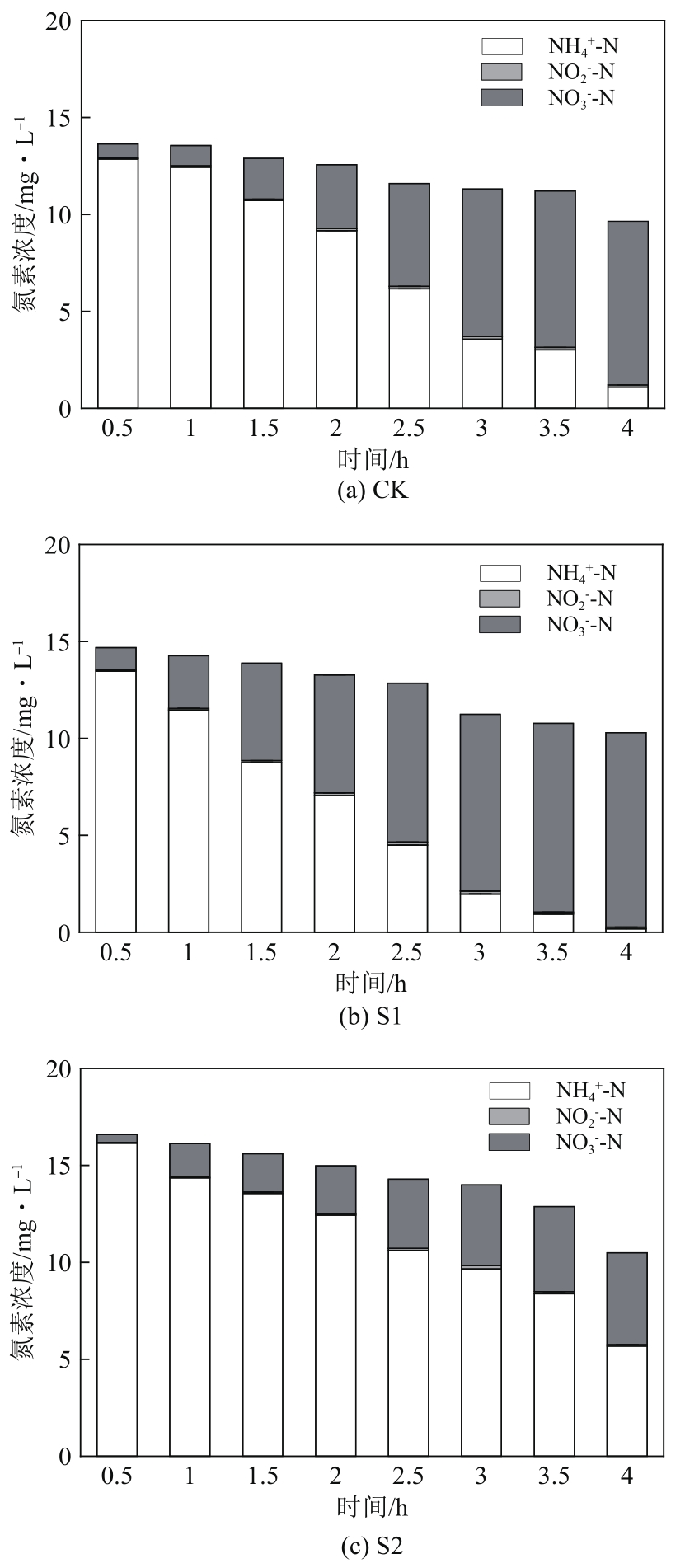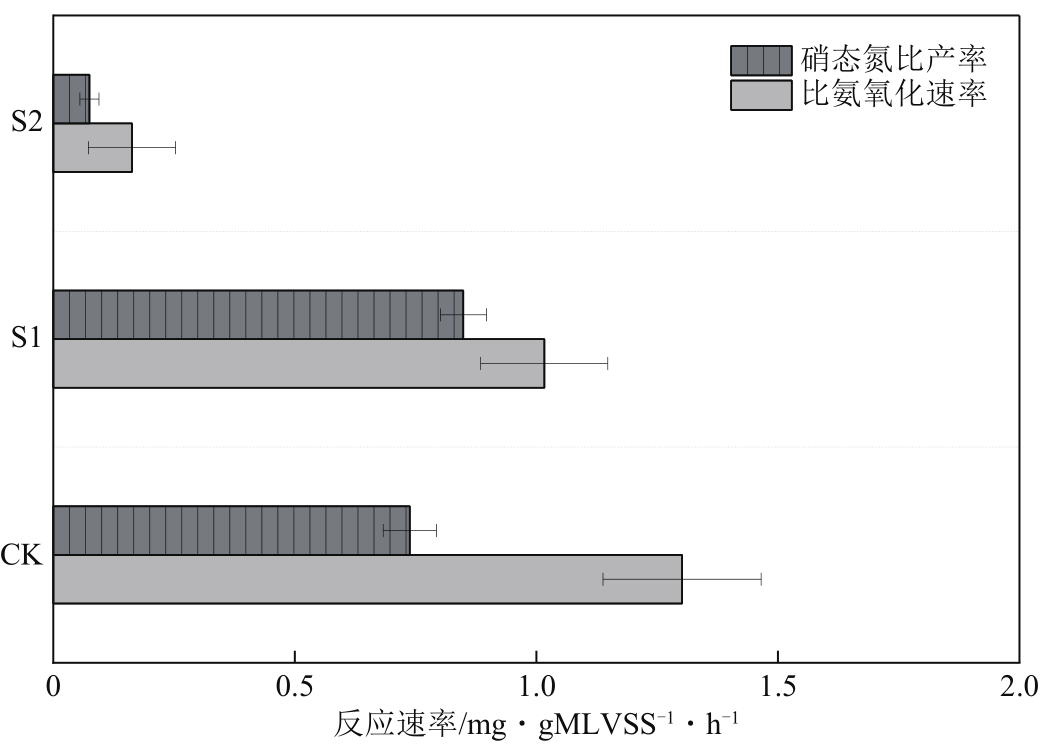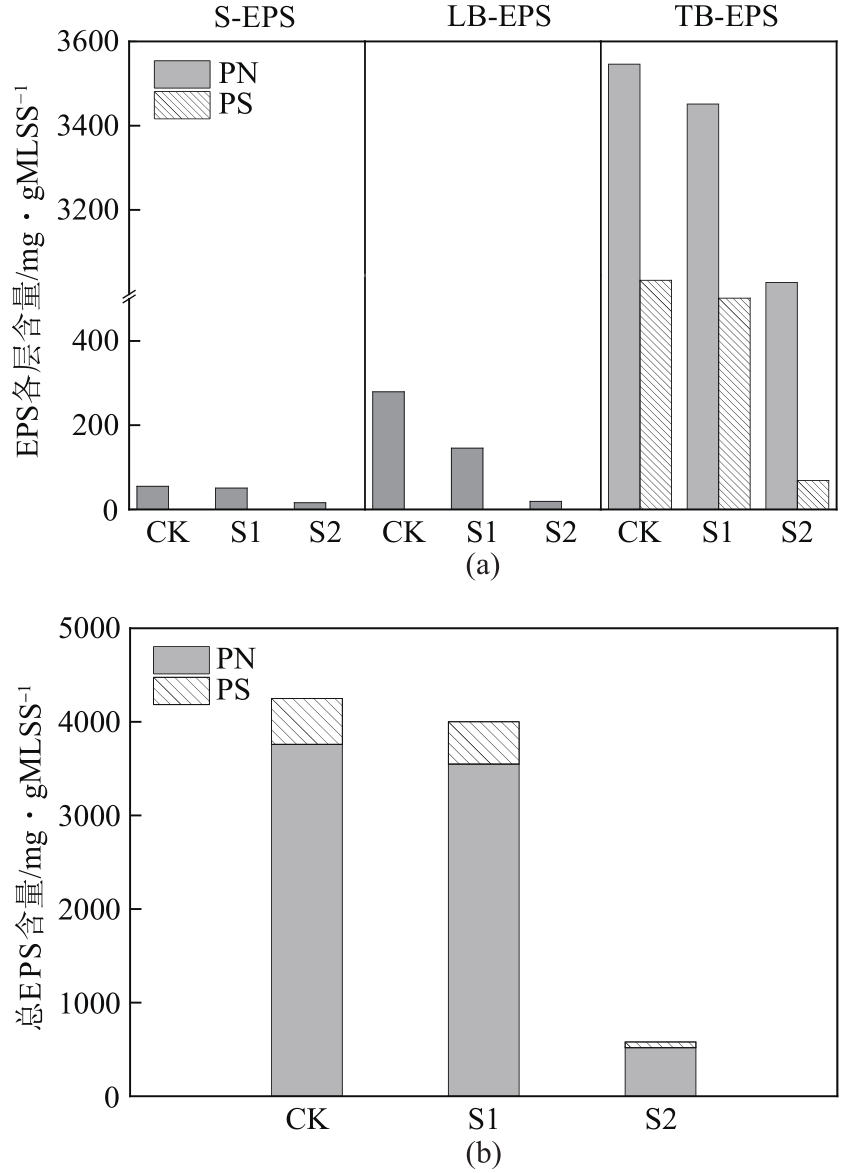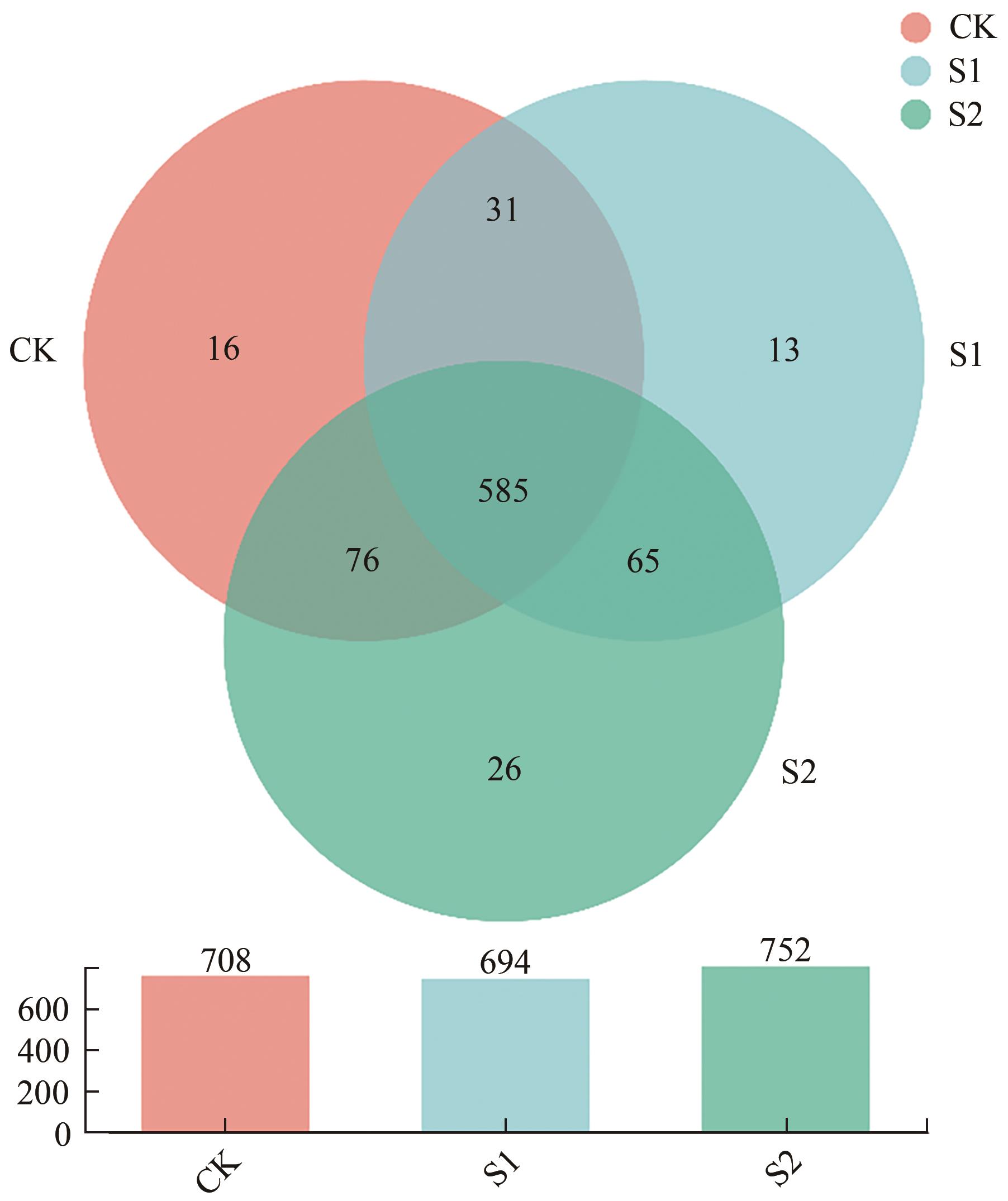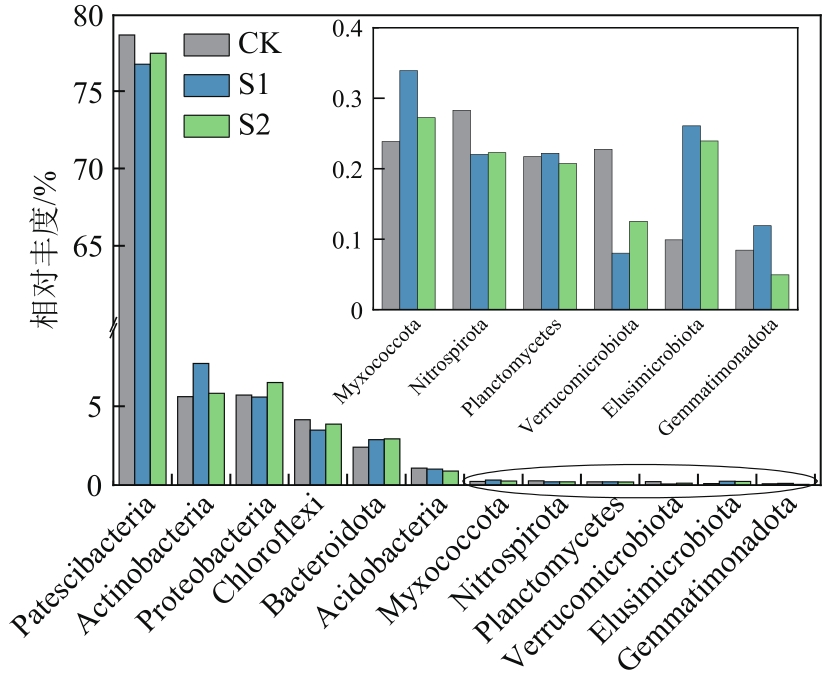Chemical Industry and Engineering Progress ›› 2023, Vol. 42 ›› Issue (2): 1051-1060.DOI: 10.16085/j.issn.1000-6613.2022-0723
• Resources and environmental engineering • Previous Articles Next Articles
Effects of exposure of polyester fiber microplastics on activated sludge system performance and microbial community structure
- College of Architecture and Environment, Sichuan University, Chengdu 610065, Sichuan, China
-
Received:2022-04-21Revised:2022-08-25Online:2023-03-13Published:2023-02-25 -
Contact:CHEN Ying
聚酯纤维微塑料胁迫下活性污泥系统性能及微生物群落的变化情况
- 四川大学建筑与环境学院,四川 成都 610065
-
通讯作者:陈滢 -
作者简介:胡璇(1999—),女,硕士研究生,研究方向为水污染控制。E-mail:573430300@qq.com。 -
基金资助:国家重点研发计划(2020YFC1909503)
CLC Number:
Cite this article
HU Xuan, CHEN Ying. Effects of exposure of polyester fiber microplastics on activated sludge system performance and microbial community structure[J]. Chemical Industry and Engineering Progress, 2023, 42(2): 1051-1060.
胡璇, 陈滢. 聚酯纤维微塑料胁迫下活性污泥系统性能及微生物群落的变化情况[J]. 化工进展, 2023, 42(2): 1051-1060.
share this article
Add to citation manager EndNote|Ris|BibTeX
URL: https://hgjz.cip.com.cn/EN/10.16085/j.issn.1000-6613.2022-0723
| SBR反应器 | pH | COD /mg·L-1 | COD去除率 /% | TN /mg·L-1 | TN去除率 /% | NH4+-N /mg·L-1 | NH4+-N去除率 /% | NO3--N /mg·L-1 | NO2--N /mg·L-1 |
|---|---|---|---|---|---|---|---|---|---|
| CK | 7.6±0.15 | 30.0±7.39 | 85.3±3.65 | 13.1±1.44 | 55.7±4.54 | 0.19±0.38 | 99.4±1.21 | 13.0±1.33 | 0.05±0.05 |
| S1 | 7.7±0.13 | 33.4±8.15 | 83.6±3.99 | 13.2±1.32 | 55.4±4.08 | 0.14±0.25 | 99.6±0.77 | 13.0±1.26 | 0.05±0.06 |
| S2 | 7.8±0.15 | 36.8±8.63 | 82.0±4.22 | 12.5±1.71 | 58.1±5.24 | 0.92±1.02 | 97.0±3.18 | 12.6±1.86 | 0.12±0.14 |
| SBR反应器 | pH | COD /mg·L-1 | COD去除率 /% | TN /mg·L-1 | TN去除率 /% | NH4+-N /mg·L-1 | NH4+-N去除率 /% | NO3--N /mg·L-1 | NO2--N /mg·L-1 |
|---|---|---|---|---|---|---|---|---|---|
| CK | 7.6±0.15 | 30.0±7.39 | 85.3±3.65 | 13.1±1.44 | 55.7±4.54 | 0.19±0.38 | 99.4±1.21 | 13.0±1.33 | 0.05±0.05 |
| S1 | 7.7±0.13 | 33.4±8.15 | 83.6±3.99 | 13.2±1.32 | 55.4±4.08 | 0.14±0.25 | 99.6±0.77 | 13.0±1.26 | 0.05±0.06 |
| S2 | 7.8±0.15 | 36.8±8.63 | 82.0±4.22 | 12.5±1.71 | 58.1±5.24 | 0.92±1.02 | 97.0±3.18 | 12.6±1.86 | 0.12±0.14 |
| 样品 | Ace | Chao 1 | Shannon | Simpson | 覆盖率 |
|---|---|---|---|---|---|
| CK | 780.11 | 769.44 | 2.95 | 0.23 | 0.99 |
| S1 | 776.40 | 765.46 | 3.05 | 0.20 | 0.99 |
| S2 | 806.64 | 795.42 | 3.07 | 0.21 | 0.99 |
| 样品 | Ace | Chao 1 | Shannon | Simpson | 覆盖率 |
|---|---|---|---|---|---|
| CK | 780.11 | 769.44 | 2.95 | 0.23 | 0.99 |
| S1 | 776.40 | 765.46 | 3.05 | 0.20 | 0.99 |
| S2 | 806.64 | 795.42 | 3.07 | 0.21 | 0.99 |
| 1 | Prabhat Kumar RAI, LEE Jechan, BROWN Richard J C, et al. Micro- and nano-plastic pollution: Behavior, microbial ecology, and remediation technologies[J]. Journal of Cleaner Production, 2021, 291: 125240. |
| 2 | 陈兴兴, 刘敏, 陈滢. 淡水环境中微塑料污染研究进展[J]. 化工进展, 2020, 39(8): 3333-3343. |
| CHEN Xingxing, LIU Min, CHEN Ying. Microplastics pollution in freshwater environment[J]. Chemical Industry and Engineering Progress, 2020, 39(8): 3333-3343. | |
| 3 | MENG Y, KELLY F J, WRIGHT S L. Advances and challenges of microplastic pollution in freshwater ecosystems: A UK perspective[J]. Environmental Pollution, 2020, 256: 113445. |
| 4 | WANG Jundong, TAN Zhi, PENG Jinping, et al. The behaviors of microplastics in the marine environment[J]. Marine Environmental Research, 2016, 113: 7-17. |
| 5 | TIAN Yujie, CHEN Zhuo, ZHANG Jiayao, et al. An innovative evaluation method based on polymer mass detection to evaluate the contribution of microfibers from laundry process to municipal wastewater[J]. Journal of Hazardous Materials, 2021, 407: 124861. |
| 6 | WAN B Z, KAO C Y, CHENG W H. Kinetics of depolymerization of poly(ethylene terephthalate) in a potassium hydroxide solution[J]. Industrial & Engineering Chemistry Research, 2001, 40(2): 509-514. |
| 7 | Xuemin LYU, DONG Qian, ZUO Zhiqiang, et al. Microplastics in a municipal wastewater treatment plant: Fate, dynamic distribution, removal efficiencies, and control strategies[J]. Journal of Cleaner Production, 2019, 225: 579-586. |
| 8 | Imran ALI, DING Tengda, PENG Changsheng, et al. Micro- and nanoplastics in wastewater treatment plants: Occurrence, removal, fate, impacts and remediation technologies—A critical review[J]. Chemical Engineering Journal, 2021, 423: 130205. |
| 9 | LIN Xumeng, SU Chengyuan, DENG Xue, et al. Influence of polyether sulfone microplastics and bisphenol A on anaerobic granular sludge: Performance evaluation and microbial community characterization[J]. Ecotoxicology and Environmental Safety, 2020, 205: 111318. |
| 10 | BRETAS ALVIM C, CASTELLUCCIO S, FERRER-POLONIO E, et al. Effect of polyethylene microplastics on activated sludge process— Accumulation in the sludge and influence on the process and on biomass characteristics[J]. Process Safety and Environmental Protection, 2021, 148: 536-547. |
| 11 | FENG Lijuan, WANG Jingjing, LIU Shuchang, et al. Role of extracellular polymeric substances in the acute inhibition of activated sludge by polystyrene nanoparticles[J]. Environmental Pollution, 2018, 238: 859-865. |
| 12 | MASON Sherri A, GARNEAU Danielle, SUTTON Rebecca, et al. Microplastic pollution is widely detected in US municipal wastewater treatment plant effluent[J]. Environmental Pollution, 2016, 218: 1045-1054. |
| 13 | MA Yini, HUANG Anna, CAO Siqi, et al. Effects of nanoplastics and microplastics on toxicity, bioaccumulation, and environmental fate of phenanthrene in fresh water[J]. Environmental Pollution, 2016, 219: 166-173. |
| 14 | MCCORMICK Amanda, HOELLEIN Timothy J, MASON Sherri A, et al. Microplastic is an abundant and distinct microbial habitat in an urban river[J]. Environmental Science & Technology, 2014, 48(20): 11863-11871. |
| 15 | HARTLINE Niko L, BRUCE Nicholas J, KARBA Stephanie N, et al. Microfiber masses recovered from conventional machine washing of new or aged garments[J]. Environmental Science & Technology, 2016, 50(21): 11532-11538. |
| 16 | 操家顺, 赵宇杰, 薛朝霞, 等. 吸附-催化材料的制备及对生活洗衣废水的处理[J]. 水处理技术, 2019, 45(5): 116-120. |
| CAO Jiashun, ZHAO Yujie, XUE Zhaoxia, et al. Preparation of adsorption-catalytic material and its performance on laundry wastewater treatment[J]. Technology of Water Treatment, 2019, 45(5): 116-120. | |
| 17 | 国家环境保护总局,水和废水监测分析方法编委会编. 水和废水监测分析方法[M]. 4版. 北京: 中国环境科学出版社, 2002. |
| STATE Environmental Protection Administration. Water and wastewater monitoring and analysis methods[M]. Beijing: China Environmental Science Press, 2002. | |
| 18 | WANG He, LI Xiufen, WANG Xinhua, et al. Insight into the distribution of metallic elements in membrane bioreactor: Influence of operational temperature and role of extracellular polymeric substances[J]. Journal of Environmental Sciences, 2019, 76: 111-120. |
| 19 | FR/OLUND B, GRIEBE T, NIELSEN P H. Enzymatic activity in the activated-sludge floc matrix[J]. Applied Microbiology and Biotechnology, 1995, 43(4): 755-761. |
| 20 | XU Jiaping, SUN Yuxiao, LIU Yi, et al. In-situ sludge settleability improvement and carbon reuse in SBR process coupled with hydrocyclone[J]. Science of the Total Environment, 2019, 695: 133825. |
| 21 | WANG Qiongjie, ZHANG Yong, WANGJIN Xiaoxue, et al. The adsorption behavior of metals in aqueous solution by microplastics effected by UV radiation[J]. Journal of Environmental Sciences, 2020, 87: 272-280. |
| 22 | TANG Taotao, CHEN Ying, LIU Min, et al. Effect of pH on the performance of hydrogen production by dark fermentation coupled denitrification[J]. Environmental Research, 2022, 208: 112663. |
| 23 | ZHAO Lijian, SU Chengyuan, LIU Weihong, et al. Exposure to polyamide 66 microplastic leads to effects performance and microbial community structure of aerobic granular sludge[J]. Ecotoxicology and Environmental Safety, 2020, 190: 110070. |
| 24 | KALČÍKOVÁ G, ALIČ B, SKALAR T, et al. Wastewater treatment plant effluents as source of cosmetic polyethylene microbeads to freshwater[J]. Chemosphere, 2017, 188: 25-31. |
| 25 | FU Shanfei, DING Jiannan, ZHANG Yun, et al. Exposure to polystyrene nanoplastic leads to inhibition of anaerobic digestion system[J]. Science of the Total Environment, 2018, 625: 64-70. |
| 26 | GREEN Dannielle Senga, BOOTS Bas, O'CONNOR Nessa E, et al. Microplastics affect the ecological functioning of an important biogenic habitat[J]. Environmental Science & Technology, 2017, 51(1): 68-77. |
| 27 | LIU Huan, ZHOU Xu, DING Wanqing, et al. Do microplastics affect biological wastewater treatment performance? implications from bacterial activity experiments[J]. ACS Sustainable Chemistry & Engineering, 2019, 7(24): 20097-20101. |
| 28 | DAI Huihui, GAO Jingfeng, WANG Zhiqi, et al. Behavior of nitrogen, phosphorus and antibiotic resistance genes under polyvinyl chloride microplastics pressures in an aerobic granular sludge system[J]. Journal of Cleaner Production, 2020, 256: 120402. |
| 29 | LI Lu, SONG Kang, YEERKEN Senbati, et al. Effect evaluation of microplastics on activated sludge nitrification and denitrification[J]. Science of the Total Environment, 2020, 707: 135953. |
| 30 | WEI Wei, HUANG Qisu, SUN Jing, et al. Polyvinyl chloride microplastics affect methane production from the anaerobic digestion of waste activated sludge through leaching toxic bisphenol-A[J]. Environmental Science & Technology, 2019, 53(5): 2509-2517. |
| 31 | EDO C, GONZÁLEZ-PLEITER M, LEGANÉS F, et al. Fate of microplastics in wastewater treatment plants and their environmental dispersion with effluent and sludge[J]. Environmental Pollution, 2020, 259: 113837. |
| 32 | CORRADINI Fabio, MEZA Pablo, EGUILUZ Raúl, et al. Evidence of microplastic accumulation in agricultural soils from sewage sludge disposal[J]. Science of the Total Environment, 2019, 671: 411-420. |
| 33 | MICHIELSSEN Marlies R, MICHIELSSEN Elien R, NI Jonathan, et al. Fate of microplastics and other small anthropogenic litter (SAL) in wastewater treatment plants depends on unit processes employed[J]. Environmental Science: Water Research & Technology, 2016, 2(6): 1064-1073. |
| 34 | QUAN Xiangchun, CEN Yan, LU Fang, et al. Response of aerobic granular sludge to the long-term presence to nanosilver in sequencing batch reactors: Reactor performance, sludge property, microbial activity and community[J]. The Science of the Total Environment, 2015, 506/507: 226-233. |
| 35 | ZOU Jinte, TAO Yaqiang, LI Jun, et al. Cultivating aerobic granular sludge in a developed continuous-flow reactor with two-zone sedimentation tank treating real and low-strength wastewater[J]. Bioresource Technology, 2018, 247: 776-783. |
| 36 | WANG Zhiqi, GAO Jingfeng, LI Dingchang, et al. Co-occurrence of microplastics and triclosan inhibited nitrification function and enriched antibiotic resistance genes in nitrifying sludge[J]. Journal of Hazardous Materials, 2020, 399: 123049. |
| 37 | SHENG Guoping, YU Hanqing, LI Xiaoyan. Extracellular polymeric substances (EPS) of microbial aggregates in biological wastewater treatment systems: A review[J]. Biotechnology Advances, 2010, 28(6): 882-894. |
| 38 | LAGARDE Fabienne, OLIVIER Ophélie, ZANELLA Marie, et al. Microplastic interactions with freshwater microalgae: Hetero-aggregation and changes in plastic density appear strongly dependent on polymer type[J]. Environmental Pollution, 2016, 215: 331-339. |
| 39 | 史文超, 桂梦瑶, 杜俊逸, 等. 典型微塑料对好氧反硝化菌群脱氮特性及反硝化相关基因的影响[J]. 环境工程学报, 2021, 15(4): 1333-1343. |
| SHI Wenchao, GUI Mengyao, DU Junyi, et al. Effects of typical microplastics on the denitrification characteristics and denitrification related genes of aerobic denitrifying bacteria[J]. Chinese Journal of Environmental Engineering, 2021, 15(4): 1333-1343. | |
| 40 | QIN Ronghua, SU Chengyuan, LIU Weihong, et al. Effects of exposure to polyether sulfone microplastic on the nitrifying process and microbial community structure in aerobic granular sludge[J]. Bioresource Technology, 2020, 302: 122827. |
| 41 | LI Chengtao, CUI Qian, LI Yan, et al. Effect of LDPE and biodegradable PBAT primary microplastics on bacterial community after four months of soil incubation[J]. Journal of Hazardous Materials, 2022, 429: 128353. |
| 42 | NGUYEN Luong N, COMMAULT Audrey S, JOHIR Md Abu Hasan, et al. Application of a novel molecular technique to characterise the effect of settling on microbial community composition of activated sludge[J]. Journal of Environmental Management, 2019, 251: 109594. |
| 43 | IANNACONE Francesca, DI CAPUA Francesco, GRANATA Francesco, et al. Simultaneous nitrification, denitrification and phosphorus removal in a continuous-flow moving bed biofilm reactor alternating microaerobic and aerobic conditions[J]. Bioresource Technology, 2020, 310: 123453. |
| 44 | WEI Wei, ZHANG Yuting, HUANG Qisu, et al. Polyethylene terephthalate microplastics affect hydrogen production from alkaline anaerobic fermentation of waste activated sludge through altering viability and activity of anaerobic microorganisms[J]. Water Research, 2019, 163: 114881. |
| 45 | LIU Yingrui, WEI Dong, XU Weiying, et al. Nitrogen removal in a combined aerobic granular sludge and solid-phase biological denitrification system: System evaluation and community structure[J]. Bioresource Technology, 2019, 288: 121504. |
| 46 | Amani A AL ALI, NADDEO Vincenzo, HASAN Shadi W, et al. Correlation between bacterial community structure and performance efficiency of a full-scale wastewater treatment plant[J]. Journal of Water Process Engineering, 2020, 37: 101472. |
| 47 | WANG Hongyu, HE Qiulai, CHEN Dan, et al. Microbial community in a hydrogenotrophic denitrification reactor based on pyrosequencing[J]. Applied Microbiology and Biotechnology, 2015, 99(24): 10829-10837. |
| 48 | JIA Liping, JIANG Binhui, HUANG Fei, et al. Nitrogen removal mechanism and microbial community changes of bioaugmentation subsurface wastewater infiltration system[J]. Bioresource Technology, 2019, 294: 122140. |
| 49 | REN X, TANG J, LIU X, et al. Effects of microplastics on greenhouse gas emissions and the microbial community in fertilized soil[J]. Environmental Pollution, 2020, 256: 113347. |
| 50 | 曾薇, 张丽敏, 王安其, 等. 污水处理系统中硝化菌的菌群结构和动态变化[J]. 中国环境科学, 2015, 35(11): 3257-3265. |
| ZENG Wei, ZHANG Limin, WANG Anqi, et al. Community structures and population dynamics of nitrifying bacteria in activated sludges of wastewater treatment plants[J]. China Environmental Science, 2015, 35(11): 3257-3265. | |
| 51 | 夏岚, 李遵龙, 郑朋. 荧光原位杂交法研究氧化沟内微生物群落分布特征[J]. 化工进展, 2012, 31(S2): 203-207. |
| XIA Lan, LI Zunlong, ZHENG Peng. Characteristics of distribution of microbial community in oxidation ditch using fluorescence in situ hybridization[J]. Chemical Industry and Engineering Progress, 2012, 31(S2): 203-207. | |
| 52 | XIA Siqing, SHI Yan, FU Yigang, et al. DGGE analysis of 16S rDNA of ammonia-oxidizing bacteria in chemical-biological flocculation and chemical coagulation systems[J]. Applied Microbiology and Biotechnology, 2005, 69(1): 99-105. |
| 53 | LI Mengqi, ZHANG Jian, LIANG Shuang, et al. Novel magnetic coupling constructed wetland for nitrogen removal: enhancing performance and responses of plants and microbial communities[J]. Science of the Total Environment, 2022, 819: 152040. |
| 54 | LIU Tao, HE Xiaolu, JIA Guangyue, et al. Simultaneous nitrification and denitrification process using novel surface-modified suspended carriers for the treatment of real domestic wastewater[J]. Chemosphere, 2020, 247: 125831. |
| 55 | Watanabe K, Kitamura T, Ogata Y, et al. Flavobacterium ammonificans sp. nov. and Flavobacterium ammoniigenes sp. nov., ammonifying bacteria isolated from surface river water[J]. International Journal of Systematic and Evolutionary Microbiology, 2022, 72(3): DOI: 10.1099/ijsem.0.005307. |
| 56 | MA Weiwei, HAN Yuxing, XU Chunyan, et al. Enhanced degradation of phenolic compounds in coal gasification wastewater by a novel integration of micro-electrolysis with biological reactor (MEBR) under the micro-oxygen condition[J]. Bioresource Technology, 2018, 251: 303-310. |
| 57 | PAN Chao, XU Dongdong, DONG Ziyang, et al. Effect of temperature decrease on anammox granular sludge: Shock and adaptation[J]. The Science of the Total Environment, 2021, 798: 149242. |
| 58 | LING S D, SINCLAIR M, LEVI C J, et al. Ubiquity of microplastics in coastal seafloor sediments[J]. Marine Pollution Bulletin, 2017, 121(1/2): 104-110. |
| 59 | ZHAO Jianwei, YUAN Qingjiang, SUN Yingjie, et al. Effect of fluoxetine on enhanced biological phosphorus removal using a sequencing batch reactor[J]. Bioresource Technology, 2021, 320: 124396. |
| [1] | CHEN Xiangyu, BIAN Chunlin, XIAO Benyi. Research progress on temperature phased anaerobic digestion technology [J]. Chemical Industry and Engineering Progress, 2023, 42(9): 4872-4881. |
| [2] | SU Jingzhen, ZHAN Jian. Research progress of microplastic removal from water environment by biochar [J]. Chemical Industry and Engineering Progress, 2023, 42(10): 5445-5458. |
| [3] | LIU Yali, ZHANG Hongwei, KANG Xiaorong. Effect and mechanisms of microplastics on anaerobic digestion of sludge [J]. Chemical Industry and Engineering Progress, 2022, 41(9): 5037-5046. |
| [4] | XU Pei, JIA Xuan, WANG Yong, QI Xuejiao, ZHAO Yujiao, LI Mingxiao. Effect of flow field on the CO2 reduction performance and products of MEC biocathode [J]. Chemical Industry and Engineering Progress, 2022, 41(7): 3816-3823. |
| [5] | CHEN Jiabo, ZHOU Xin, LI Xu. Rapid start-up and nitrogen removal performance of anammox process using activated sludge as an inoculation [J]. Chemical Industry and Engineering Progress, 2022, 41(7): 3900-3907. |
| [6] | PAN Wenzheng, JI Zhiyong, WANG Jing, LI Shuming, HUANG Zhihui, GUO Xiaofu, LIU Jie, ZHAO Yingying, YUAN Junsheng. Research on the electricity production performance and degradation process of microbial fuel cell treating azo-dye saline wastewater [J]. Chemical Industry and Engineering Progress, 2022, 41(6): 3306-3313. |
| [7] | WANG Yuguang, ZHANG Xingxing, WANG Chaochao, XIA Yunkang, WANG Yao, ZHOU Cheng, WU Yiling, WU Peng, XU Lezhong. Achieving advanced nitrogen and phosphorus removal based on denitrifying phosphorus removal and partial denitrification Anammox process [J]. Chemical Industry and Engineering Progress, 2022, 41(4): 2191-2201. |
| [8] | JING Shuangyi, LIU Chao, CAI Yiting, LI Weiping, YU Linghong, HOU Na. Enhancement of nitrification performance of MBBR at low temperature by magnetic carrier and its microbial community analysis [J]. Chemical Industry and Engineering Progress, 2022, 41(4): 2180-2190. |
| [9] | CHEN Guodong, LIU Haicheng, MENG Wushuang, YOU Yu, ZHANG Hao, CAO Mengru. Research progress on artificial intervention and characterization of physicochemical properties of microplastics aging [J]. Chemical Industry and Engineering Progress, 2022, 41(12): 6443-6453. |
| [10] | YANG Jingrui, WANG Ying, CHEN Hu, LYU Yongkang. Effects of O2 concentration on adjusting NO x oxidation ratio cooperated with CABR system denitration performance and microbial community structure [J]. Chemical Industry and Engineering Progress, 2022, 41(11): 6139-6148. |
| [11] | ZHANG Yashan, CHEN Zongyao, MA Weifang. Research progress on the migration and transformation of microplastics and environmental risks [J]. Chemical Industry and Engineering Progress, 2022, 41(11): 6080-6098. |
| [12] | ZHANG Lanhe, YUAN Zhentao, ZHAO Haojie, ZHAO Juntian, ZHU Yining, CHEN Zicheng, JIA Yanping, TIAN Shulei. Effect of external electric current on denitrification efficiency and sludge flocculation of anoxic zone using AO process [J]. Chemical Industry and Engineering Progress, 2021, 40(11): 6369-6377. |
| [13] | Guozhi FU, Wenyang GUO, Zonghu MA, Wei LIU, Bokai LI, Ziyan SUN, Zhenxin WANG, Yeqing LI. Analysis of gas generation performance and key microorganisms of high solid anaerobic digestion of straw mixed with pig manure [J]. Chemical Industry and Engineering Progress, 2020, 39(8): 3386-3394. |
| [14] | Xingxing CHEN, Min LIU, Ying CHEN. Microplastics pollution in freshwater environment [J]. Chemical Industry and Engineering Progress, 2020, 39(8): 3333-3343. |
| [15] | Qiongjie WANG,Yong ZHANG,Yu CHEN,Jinxiaoxue WANG,Yimei WANG. Research progress on environmental influence behavior of microplastics in water [J]. Chemical Industry and Engineering Progress, 2020, 39(4): 1500-1510. |
| Viewed | ||||||
|
Full text |
|
|||||
|
Abstract |
|
|||||


